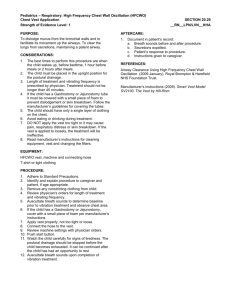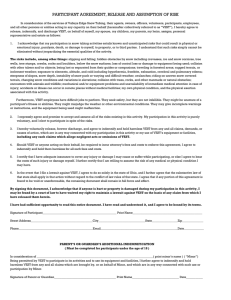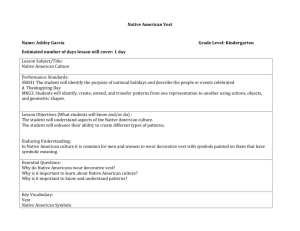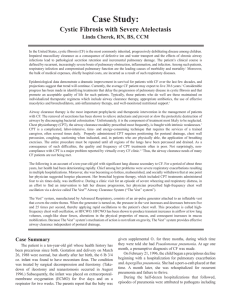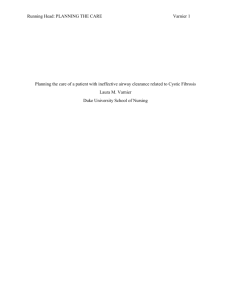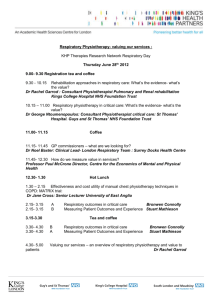Chest Physiotherapy Using the Vest
advertisement
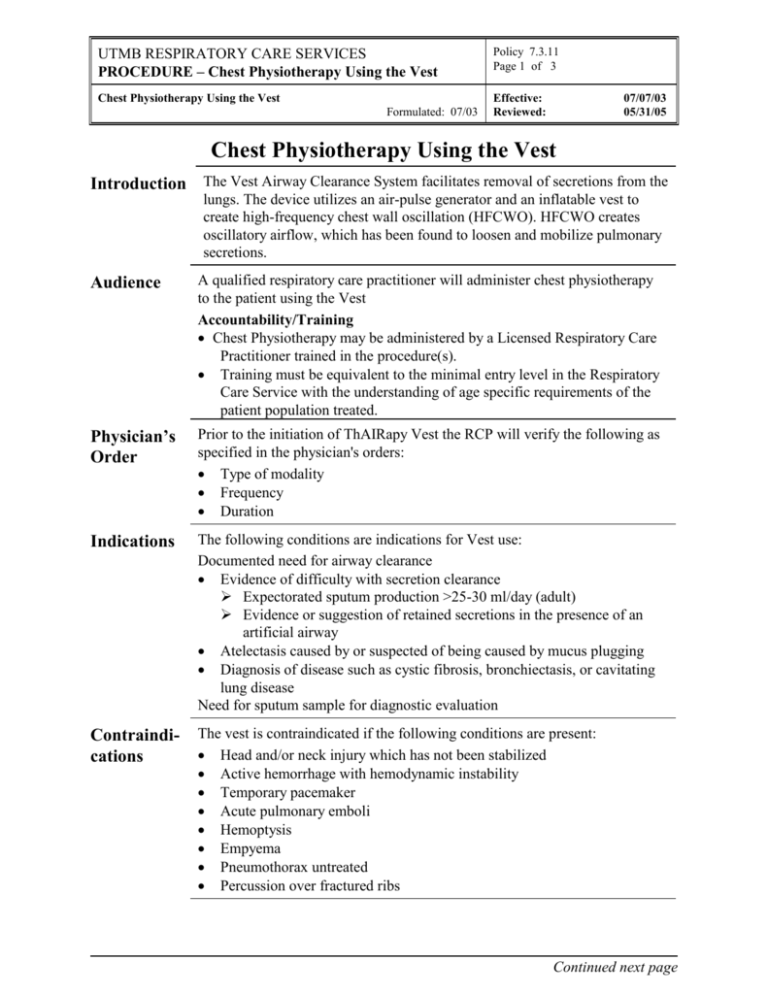
UTMB RESPIRATORY CARE SERVICES PROCEDURE – Chest Physiotherapy Using the Vest Policy 7.3.11 Page 1 of 3 Chest Physiotherapy Using the Vest Effective: Reviewed: Formulated: 07/03 07/07/03 05/31/05 Chest Physiotherapy Using the Vest Introduction The Vest Airway Clearance System facilitates removal of secretions from the lungs. The device utilizes an air-pulse generator and an inflatable vest to create high-frequency chest wall oscillation (HFCWO). HFCWO creates oscillatory airflow, which has been found to loosen and mobilize pulmonary secretions. Audience A qualified respiratory care practitioner will administer chest physiotherapy to the patient using the Vest Accountability/Training Chest Physiotherapy may be administered by a Licensed Respiratory Care Practitioner trained in the procedure(s). Training must be equivalent to the minimal entry level in the Respiratory Care Service with the understanding of age specific requirements of the patient population treated. Physician’s Order Prior to the initiation of ThAIRapy Vest the RCP will verify the following as specified in the physician's orders: Type of modality Frequency Duration Indications The following conditions are indications for Vest use: Documented need for airway clearance Evidence of difficulty with secretion clearance Expectorated sputum production >25-30 ml/day (adult) Evidence or suggestion of retained secretions in the presence of an artificial airway Atelectasis caused by or suspected of being caused by mucus plugging Diagnosis of disease such as cystic fibrosis, bronchiectasis, or cavitating lung disease Need for sputum sample for diagnostic evaluation Contraindications The vest is contraindicated if the following conditions are present: Head and/or neck injury which has not been stabilized Active hemorrhage with hemodynamic instability Temporary pacemaker Acute pulmonary emboli Hemoptysis Empyema Pneumothorax untreated Percussion over fractured ribs Continued next page UTMB RESPIRATORY CARE SERVICES PROCEDURE – Chest Physiotherapy Using the Vest Policy 7.3.11 Page 2 of 3 Chest Physiotherapy Using the Vest Effective: Reviewed: Formulated: 07/03 Procedure 07/07/03 05/31/05 Once an order has been obtained for ThAIRapy Vest the RCP will utilize the following outline: Action Step 1. Instruct patient: Comfortable body position Breathing pattern (i.e. sighing, huffing, coughing) Machine controls 2. Place the vest on the patient and check for proper fit: With the vest deflated, adjust the closures so that the vest fits comfortably The vest should rest on the shoulder and extend to the top of the hipbone Breathing should not be restricted when the vest is deflated. For comfort, a single layer of clothing may be worn during the therapy session 3. Position the patient: Head in the neutral position Mouth should be maintained in a slightly open position 4. Connect the tubing to the generator and the ports of the vest 5. If aerosol therapy is prescribed, assemble nebulizer and other equipment needed for aerosol delivery 6. Turn on the Main Power switch 7. Adjust the Pressure Control: pressures between 5 and 6 are commonly used 8. Adjust the Frequency Control: frequencies between 10 and 15 are commonly used. 9. Begin aerosol therapy if prescribed 10. Depress and maintain pressure on the Foot/Hand Control to initiate Vest therapy 11. After completing 5-10 minutes of pulsation, release the hand/foot control. Cough, huff or suction to clear loosened secretions. 12 Continue treatment (duration 15-30 minutes). Continued next page UTMB RESPIRATORY CARE SERVICES PROCEDURE – Chest Physiotherapy Using the Vest Policy 7.3.11 Page 3 of 3 Chest Physiotherapy Using the Vest Effective: Reviewed: Formulated: 07/03 Adverse Effects 07/07/03 05/31/05 Decreased Oxygenation Increased ventilatory drive Increased Heart rate Desaturation Bronchospasm Wheezing Short of Breath Pulmonary Hemorrhage Frank hemoptysis Shortness of breath In the event the patient demonstrates signs of decreased oxygenation, pulmonary hemorrhage or bronchoconstriction, therapy will be stopped. Assess the situation and do the following: Inform the charge nurse Inform the physician Chart the appropriate information Further treatments will not be given until the physician is aware of the situation and has provided appropriate orders. Infection Control Follow as outlined in: Reference AARC Clinical Practice Guidelines; Respiratory Care; 1991; 36: 1414-1426 Postural Drainage Therapy Follow procedures as outlined Healthcare Epidemiology Policies and Procedures: #2.24 Respiratory Care Services. http://www.utmb.edu/policy/hcepidem/search/02-24.pdf Healthcare Epidemiology Policies and Procedures #1.5; Cleaning and Reprocessing of Patient Care Equipment and Medical Devices. http://www.utmb.edu/policy/hcepidem/search/01-05.pdf Langenderfer B. Alternatives to percussion and postural drainage. A review of mucus clearance therapies: percussion and postural drainage, autogenic drainage, positive expiratory pressure, flutter valve, intrapulmonary percussive ventilation, and high-frequency chest compression with the ThAIRapy Vest. J Cardiopulmonary Rehabilitation. 1998; 18:283-289. Advanced Respiratory; The Vest Airway Clearance System Instruction Manual
